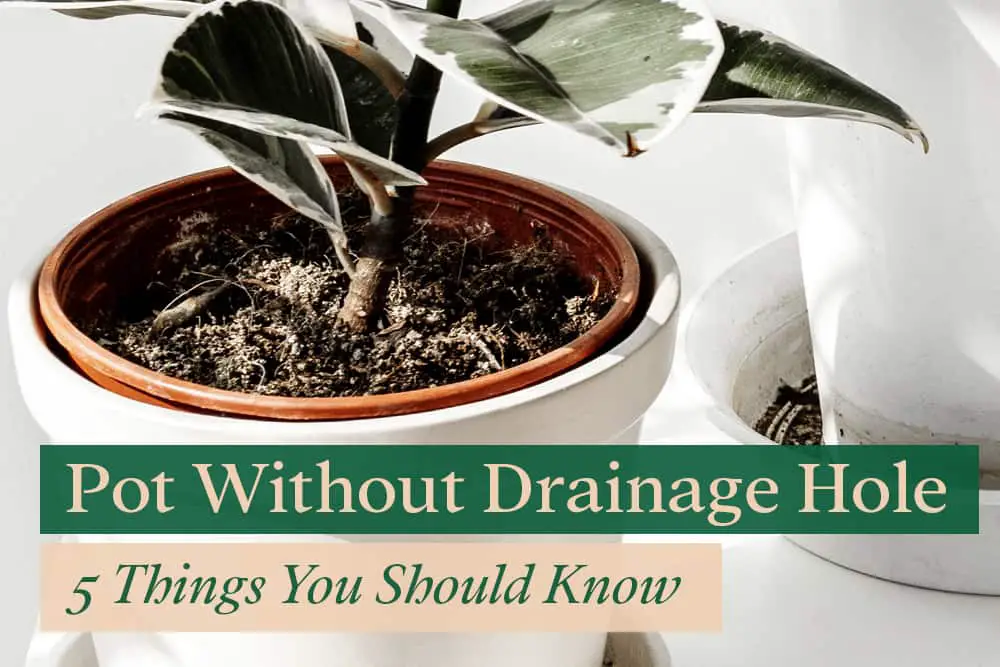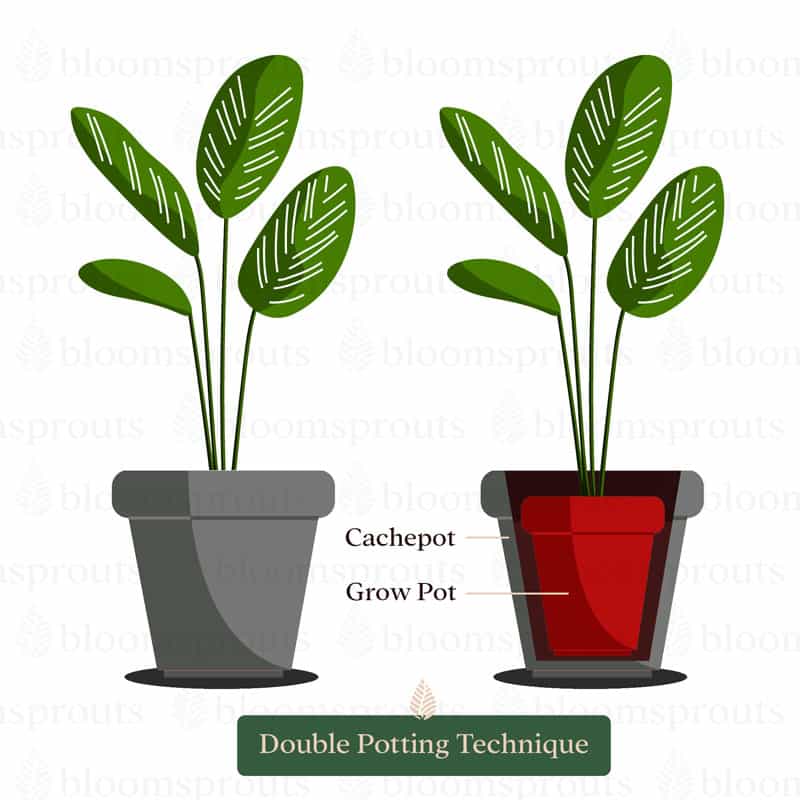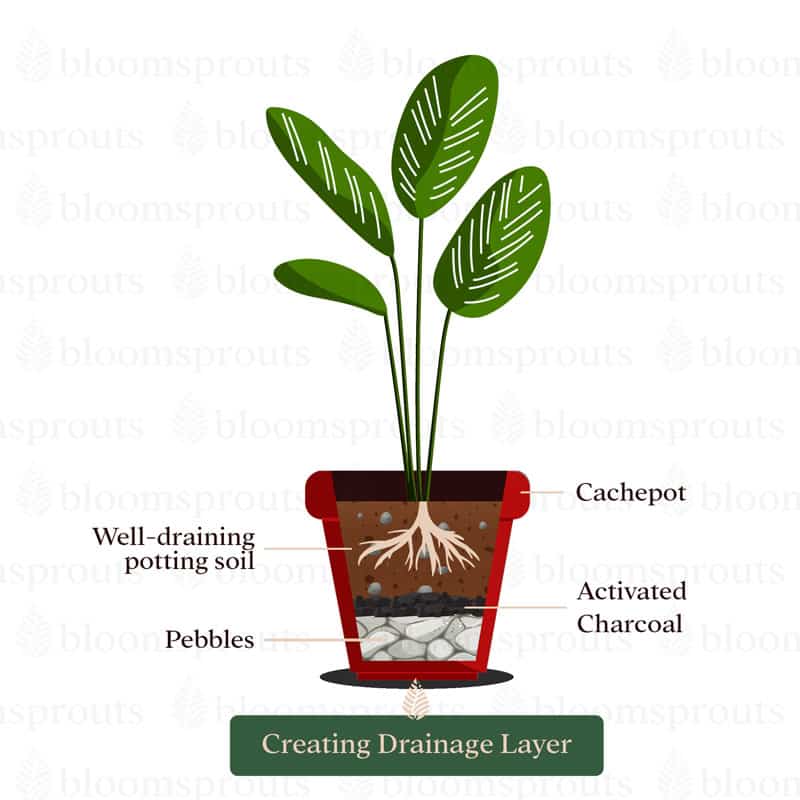
Did you ever wonder why some of the most beautiful plant pots don’t have drainage holes? Could you use it for your prized houseplants?
Plant pots without drainage holes are known as cachepots, and they are commonly used to aesthetically hide grow pots that hold houseplants. Planting directly into decorative containers increases the risk of overwatering.
In this article, you will also learn how to properly use cachepots, either as decorative pots or for growing directly in them. In addition, I will share some tips for growing plants directly in these containers.
Let’s get started!
Why Cachepots Don’t Have Drainage Holes

Excess water and damp soil tend to flow out of drainage holes for up to 24 hours after plants are watered. Consequently, placing the planter pots on the furniture or flooring could cause it to stain.
You can either move the plants outside for watering or place plastic saucers under the pots to prevent staining.
However, many commercial plant installations such as in offices, lobbies, restaurants and hotels utilize cachepots without drainage holes to reduce the mess and hassle of moving the plants every time the plants need watering.
Since these cachepots are primarily used in commercial buildings, their design should complement the interior. This is why there is a high demand for beautiful pots without drainage holes.
Why Drainage Holes are Important
Think about it, whenever you buy plants from a nursery, they always come in pots with drainage holes. But why?
The drainage holes under your plant containers are essential for letting water in the soil to drain freely, as well as allowing adequate oxygen to reach the roots. Also through the holes, salts buildup from fertilizer can be flushed out of the soil.
Drainage holes allow water to drain between waterings
Without the drainage under the pot, water will pool at the bottom of the pot without anywhere to go. Although the surface of the soil may appear dry, the soil at the bottom will be soaking wet.
Apart from a few aquatic plants, most plants do not like to have their roots sit in water for too long. Waterlogged soil inhibits airflow to the roots, which can cause root rot, an irreversible condition that can cause your plant to wilt quickly.
Drainage holes avoid salt build-up in the soil
The use of tap water and fertilizer on your plants can cause salt to accumulate on the potting soil over time. The salt buildup makes it difficult for plants to absorb water, resulting in dehydration and root rot.
Occasionally rinsing your potting soil with the vinegar-water solution will prevent salt buildup. If you frequently fertilize your plants, you can flush them once a month. The vinegar will also help lower soil pH and neutralize salts in the soil.
When flushing salts from soils, you want to make sure that the water drains freely from the bottom of the pot. If there are no proper drainage holes, the salts will accumulate at the bottom of the pot and the soil will also become waterlogged.
How to Use Pots with No Drainage Holes
Now, what if we already own a really beautiful pot, but the bottom does not have a drainage hole? Can we still use it without worrying about overwatering our prized houseplant?
1. Using the pot as a cachepot
As I explained earlier, it has been common practice to use containers without drainage holes as cachepots. This practice is referred to as double potting.

First, you will need to plant your houseplant in a smaller grow pot with at least a drainage hole. After that, you can place the smaller pot inside the larger decorative cachepot.
When your plant needs watering, simply remove the smaller pot and give it plenty of water. Allow the water to drain thoroughly, then replace the pot back into the decorative pot.
A plastic saucer can also be placed under the grow pot to make it easier to remove excess water.
But what about if your original grow pot is larger than your cachepot? In this case, you will need to either repot or propagate the plant into a smaller pot first.
2. Drill a drainage hole on the cachepot
Now, if you would like to plant directly into the cachepot, you will need to drill a drainage hole into the bottom of the pot.
Yes, it is possible to drill a drainage hole into almost every material of cachepot, even if the pot is made from glass.
When drilling the hole, I highly recommend using the diamond drill bits instead of the usual pointy bits. They have a rough texture that makes drilling more precise and easier.
First, mark the spots you plan to drill. Then start drilling at 45 degrees at a slow steady pace to avoid cracking. Don’t apply too much pressure, and most importantly, let the drill do the work.
Regularly add small amounts of water to minimize dust from the drilling and keep the drill bits from overheating.
3. Place layers of rock at the bottom of the pot
If you are concerned about damaging the cachepot when drilling it, you can use the following technique to create draining layers inside:

Start by filling your pot with pebbles or landscape rocks up to ¼ of the height of the pot. Depending on the size of your pot, you may use smaller or larger rocks. Generally, I use 1-inch rocks for pots up to 12 inches in diameter.
Next, put a thin layer of Activated Charcoal as the second layer, about an inch high. Besides helping to drain, the activated charcoal also absorbs excess moisture and prevents root rot.
The third layer should be filled with well-draining potting soil about halfway up the pot. For larger plants, you can add more soil to provide more room for future root growth.
After your drainage layers are in place, you can place your plant in the pot and fill the pot with soil.
But remember this, even if you have created a draining layer, you still need to be cautious when watering your plants. Overwatering will still kill your plants.
You should always use a soil meter before watering your plants to check how moist the soil is around their rootballs.
Caring Tips for Direct Planting in Pot Without Drainage Holes
You are probably aware by now how susceptible your plants to root rot when you plant directly into the cachepot. Unless you provide your plant with the right conditions, it will suffer and wilt.
So, here are some tips for caring for plants in pots without drainage holes:
1. Do not over-water
I think it is obvious not to overwater your plants in cachepots as there is no way for excess water to drain completely. But how much water should you give?
Generally, I use an amount of water equal to half the volume of the container. In the case of an 8″ pot, which has a volume of one gallon (about four liters), I use 0.5 gallons (about two liters) of water.
| Pot Size (inches) | Pot Volume (U.S. Gallons) | Amount of Water (U.S. Gallons) |
|---|---|---|
| 4″ pot | pint / 0.5 quart /.125 gallon | 0.25 quart |
| 5-6″ pot | quart / 0.25 gallon | 0.5 quart / .125 gallon |
| 7-8″ pot | 1 gallon | 0.5 gallon |
| 8.5″ pot | 2 gallon | 1 gallon |
| 10″ pot | 3 gallon | 1.5 gallon |
| 11″ pot | 4 gallon | 2 gallon |
| 12″ pot | 5 gallon | 2.5 gallon |
| 13″ pot | 6 gallon | 3 gallon |
| 14″ pot | 7 gallon | 3.5 gallon |
| 16″ pot | 10 gallon | 5 gallon |
| 18″ pot | 15 gallon | 7.5 gallon |
| 21″ pot | 20 gallon | 10 gallon |
| 24″ pot | 25 gallon | 12.5 gallon |
| 30″ pot | 30 gallon | 15 gallon |
Before you water your plant, always make sure that the top two inches of the soil are completely dry.
2. Provide bright, indirect light
When planting directly in pots without drainage holes, avoid placing plants in low light areas such as a bathroom. This will prevent soil from drying out and keep roots moist longer.
Instead, you should give your plants plenty of bright light so they can optimize photosynthesis and absorb the water in the pot.
However, if your cachepots are made of terracotta, you can place them in a shadier area since their porous surface is able to let water seep out slowly even without drainage holes.
3. Avoid placing the pot outdoors
In my misguided attempt to keep my cachepot plants alive, I left some outside while I was at work. It was a very cloudy day, but I thought it would give them more light.
But I was wrong!
My cachepot plants completely drowned when it rained that day, causing the soil to overflow out of the pot. Emptying out the water was also difficult as the pot became so heavy to tip over.
Having learned from that experience, I recommend you do not put plants in pots without drainage holes outside, especially if you are planning on being away for a long period of time.
4. Do not use oversize cachepots
If the pot diameter is too wide, the area without roots will stay wet longer, promoting the growth of fungi that lead to root rot.
Choosing a tall cachepot, on the other hand, may give you the opportunity to create a better drainage layer at the bottom.
5. Use organic fertilizers only
Using chemical fertilizer can leave a salt residue in the soil that needs to be flushed regularly. With no drainage, salts in the soil are unable to leech out and can cause root burn over time.
It’s better to use organic fertilizer since it doesn’t contain salt. I personally use Miracle-Gro Performance Organics, and my plants are happy and produce new growth regularly.
What plants do well without drainage?
There are some plants that do better in containers without drainage holes than others. Here are some that I know do well:
- Succulent
- Snake plants
- Rough Horsetail
- Chinese evergreen
- Spider plant
- ZZ plant
- Dumb cane
- Pothos
Some of my Philodendrons and Monsteras are potted without drainage holes. Despite the fact that they would probably benefit from drainage, they are doing so well in their current pots that I don’t want to disturb them.
